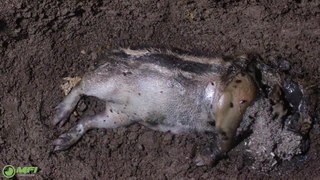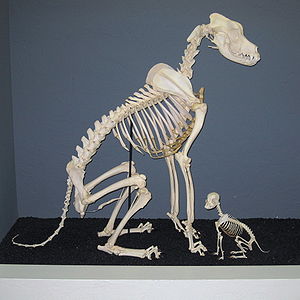
Forensic entomology is the scientific study of the colonization of a dead body by arthropods. This includes the study of insect types commonly associated with cadavers, their respective life cycles, their ecological presences in a given environment, as well as the changes in insect assemblage with the progression of decomposition. Insect succession patterns are identified based on the time a given species of insect spends in a given developmental stage, and how many generations have been produced since the insects introduction to a given food source. Insect development alongside environmental data such as temperature and vapor density, can be used to estimate the time since death, due to the fact that flying insects are attracted to a body immediately after death. The identification of postmortem interval to aid in death investigations is the primary scope of this scientific field. However, forensic entomology is not limited to homicides, it has also been used in cases of neglect and abuse, in toxicology contexts to detect the presence of drugs, and in dry shelf food contamination incidents. Equally, insect assemblages present on a body, can be used to approximate a given location, as certain insects may be unique to certain areas. Therefore, forensic entomology can be divided into three subfields: urban, stored-product and medico-legal/medico-criminal entomology.

Decomposition or rot is the process by which dead organic substances are broken down into simpler organic or inorganic matter such as carbon dioxide, water, simple sugars and mineral salts. The process is a part of the nutrient cycle and is essential for recycling the finite matter that occupies physical space in the biosphere. Bodies of living organisms begin to decompose shortly after death. Animals, such as worms, also help decompose the organic materials. Organisms that do this are known as decomposers or detritivores. Although no two organisms decompose in the same way, they all undergo the same sequential stages of decomposition. The science which studies decomposition is generally referred to as taphonomy from the Greek word taphos, meaning tomb. Decomposition can also be a gradual process for organisms that have extended periods of dormancy.

Taphonomy is the study of how organisms decay and become fossilized or preserved in the paleontological record. The term taphonomy was introduced to paleontology in 1940 by Soviet scientist Ivan Efremov to describe the study of the transition of remains, parts, or products of organisms from the biosphere to the lithosphere.

A lye is an alkali metal hydroxide traditionally obtained by leaching wood ashes (potassium), or a strong alkali which is highly soluble in water producing caustic basic solutions. "Lye" most commonly refers to sodium hydroxide (NaOH), but historically has been used for potassium hydroxide (KOH).
Putrefaction is the fifth stage of death, following pallor mortis, livor mortis, algor mortis, and rigor mortis. This process references the breaking down of a body of an animal post-mortem. In broad terms, it can be viewed as the decomposition of proteins, and the eventual breakdown of the cohesiveness between tissues, and the liquefaction of most organs. This is caused by the decomposition of organic matter by bacterial or fungal digestion, which causes the release of gases that infiltrate the body's tissues, and leads to the deterioration of the tissues and organs. The approximate time it takes putrefaction to occur is dependent on various factors. Internal factors that affect the rate of putrefaction include the age at which death has occurred, the overall structure and condition of the body, the cause of death, and external injuries arising before or after death. External factors include environmental temperature, moisture and air exposure, clothing, burial factors, and light exposure. Body farms are facilities that study the way various factors affect the putrefaction process.

A maggot is the larva of a fly ; it is applied in particular to the larvae of Brachycera flies, such as houseflies, cheese flies, and blowflies, rather than larvae of the Nematocera, such as mosquitoes and crane flies.

Trogidae, sometimes called hide beetles, is a family of beetles with a distinctive warty or bumpy appearance. Found worldwide, the family includes about 300 species contained in four or five genera.

Chicken is the most common type of poultry in the world. Owing to the relative ease and low cost of raising chickens—in comparison to mammals such as cattle or hogs—chicken meat and chicken eggs have become prevalent in numerous cuisines.

Skeletonization is the state of a dead organism after undergoing decomposition. Skeletonization refers to the final stage of decomposition, during which the last vestiges of the soft tissues of a corpse or carcass have decayed or dried to the point that the skeleton is exposed. By the end of the skeletonization process, all soft tissue will have been eliminated, leaving only disarticulated bones.
Forensic entomological decomposition is how insects decompose and what that means for timing and information in criminal investigations. Medicolegal entomology is a branch of forensic entomology that applies the study of insects to criminal investigations, and is commonly used in death investigations for estimating the post-mortem interval (PMI). One method of obtaining this estimate uses the time and pattern of arthropod colonization. This method will provide an estimation of the period of insect activity, which may or may not correlate exactly with the time of death. While insect successional data may not provide as accurate an estimate during the early stages of decomposition as developmental data, it is applicable for later decompositional stages and can be accurate for periods up to a few years.
The University of Tennessee Anthropological Research Facility, better known as the Body Farm and sometimes seen as the Forensic Anthropology Facility, was conceived in 1971 and established in 1972 by anthropologist William M. Bass as the first facility for the study of decomposition of human remains. It is located a few miles from downtown Knoxville, Tennessee, US, behind the University of Tennessee Medical Center, and is part of the Forensic Anthropology Center, which was established by Dr. Bass in 1987.

Muscina is a genus of flies that belongs to the family Muscidae, currently consisting of 27 species. They are worldwide in distribution and are frequently found in livestock facilities and outside restrooms. The most common species are M. stabulans, M. levida, and M. prolapsa. Muscina flies commonly breed in manure and defecate on food, which has been linked to the spread of some disease and illnesses. The occurrence of Muscina larvae on dead bodies has led to their regular use in forensic investigations, as they may be used to estimate the time of death. Research have shown the prevalence of certain species of Muscina flies as vectors of diseases such as poliomyelitis.
Calliphora loewi is part of the family Calliphoridae, bottle flies and blowflies, and in the genus Calliphora, blue bottle flies. The genus can be deceiving since C. loewi is not blue. Though this species is rare, it can play an important part in forensic entomology, spreading disease, and decomposing carrion. The life cycle of C. loewi is similar to the life cycle of the genus Calliphora. Since this species is rare there has not been very much research done with this species.
Decomposition in animals is a process that begins immediately after death and involves the destruction of soft tissue, leaving behind skeletonized remains. The chemical process of decomposition is complex and involves the breakdown of soft tissue, as the body passes through the sequential stages of decomposition. Autolysis and putrefaction also play major roles in the disintegration of cells and tissues.

Unidentified decedent, or unidentified person, is a corpse of a person whose identity cannot be established by police and medical examiners. In many cases, it is several years before the identities of some UIDs are found, while in some cases, they are never identified. A UID may remain unidentified due to lack of evidence as well as absence of personal identification such as a driver's license. Where the remains have deteriorated or been mutilated to the point that the body is not easily recognized, a UID's face may be reconstructed to show what they had looked like before death. UIDs are often referred to by the placeholder names "John Doe" or "Jane Doe".

Conservation-restoration of bone, horn, and antler objects involves the processes by which the deterioration of objects either containing or made from bone, horn, and antler is contained and prevented. Their use has been documented throughout history in many societal groups as these materials are durable, plentiful, versatile, and naturally occurring/replenishing.

Necrophages are organisms that obtain nutrients by consuming decomposing dead animal biomass, such as the muscle and soft tissue of carcasses and corpses. The term derives from Greek nekros, meaning 'dead', and phagein, meaning 'to eat.' Mainly, necrophages are species within the phylum Arthropoda; however, other animals, such as gastropods and Accipitrimorphae birds have been noted to engage in necrophagy.
The necrobiome has been defined as the community of species associated with decaying corpse remains. The process of decomposition is complex. Microbes decompose cadavers, but other organisms including fungi, nematodes, insects, and larger scavenger animals also contribute. Once the immune system is no longer active, microbes colonizing the intestines and lungs decompose their respective tissues and then travel throughout the body via the blood and lymphatic systems to break down other tissue and bone. During this process, gases are released as a by-product and accumulate, causing bloating. Eventually, the gases seep through the body's wounds and natural openings, providing a way for some microbes to exit from the inside of the cadaver and inhabit the outside. The microbial communities colonizing the internal organs of a cadaver are referred to as the thanatomicrobiome. The region outside of the cadaver that is exposed to the external environment is referred to as the epinecrotic portion of the necrobiome, and is especially important when determining the time and location of death for an individual. Different microbes play specific roles during each stage of the decomposition process. The microbes that will colonize the cadaver and the rate of their activity are determined by the cadaver itself and the cadaver's surrounding environmental conditions.

Jay Villemarette is the owner, founder and president of both Skulls Unlimited International, Inc. and SKELETONS: Museum of Osteology.

Decomposition is the process in which the organs and complex molecules of animal and human bodies break down into simple organic matter over time. In vertebrates, five stages of decomposition are typically recognized: fresh, bloat, active decay, advanced decay, and dry/skeletonized. Knowing the different stages of decomposition can help investigators in determining the post-mortem interval (PMI). The rate of decomposition of human remains can vary due to environmental factors and other factors. Environmental factors include temperature, burning, humidity, and the availability of oxygen. Other factors include body size, clothing, and the cause of death.















